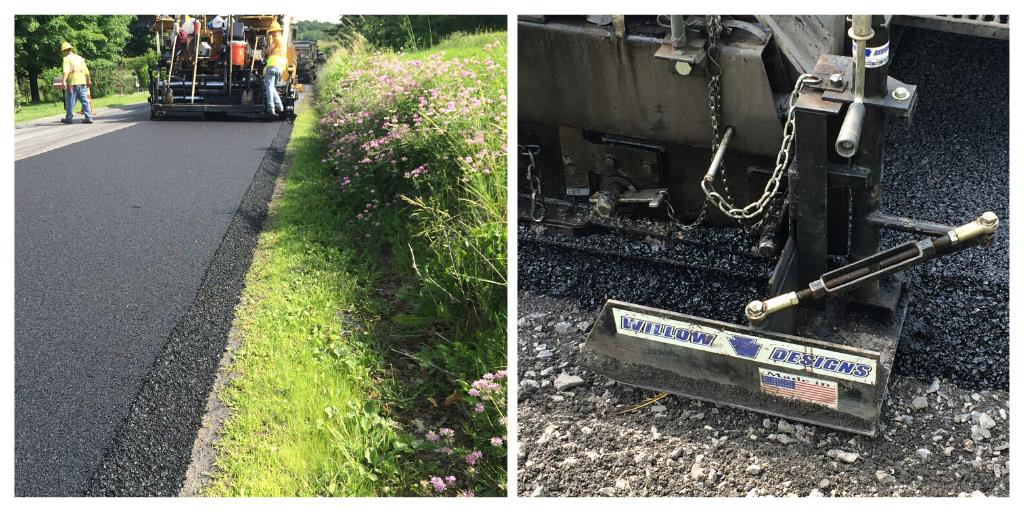
When people think of what they rely on PennDOT for, perhaps paving is one of the most important missions the state transportation agency delivers.
In its efforts to be as innovative as possible, PennDOT embraced the Safety Edge SM paving technique. This approach minimizes vertical drop off at the pavement edge, making it easier for vehicles that drift off the road to return safely.
"We routinely use this method of construction statewide in Pennsylvania and use it in District 9 (the Blair County and surrounding region) on every project that meets Publication 408 criteria, such as pavement that doesn't encounter curbs or sidewalks or pavement that doesn't have the face of the guiderail directly over its edges," said Garth Bridenbaugh, District 9 construction services engineer.
"PennDOT implemented Safety Edge SM as part of Federal Highway Administration (FHWA) Every Day Counts Round 1 (EDC-1). PennDOT agreed to pilot it, which began in 2011, then implemented it on a statewide level soon after. Currently, it has widespread use across the state and is part of the standards and specifications."
The edge is installed with a shoe that easily attaches to existing paving equipment.
Safety Edge SM is now included in the PennDOT Design Manual and is to be used as a standard pavement edge treatment for bituminous pavements and shoulders, except in urban areas with curbs and sidewalks.
Safety Edge SM is one of the innovations that was championed by the Pennsylvania State Transportation Innovation Council.
One additional benefit, said Mark Colussy, planning director for Huntingdon County, located in the District 9 area, is the additional width of the roadway with the Safety Edge SM application.
"We can use as much cartway as we can get on our rural roads," he said.
Colussy said he was pleased with PennDOT District 9's offering a combination of improved technology, better roadways and cost savings.
"I am a fan of the innovative technologies …. and am supportive of looking at other opportunities," he added.
ABOUT THIS BLOG
Did you know PennDOT is directly responsible for nearly 40,000 miles of highway and roughly 25,000 bridges? We oversee programs and policies affecting highways, urban and rural public transportation, airports, railroads, ports and waterways, in addition to administering the state's more than 11 million vehicle registrations and 8.8 million driver's licenses.
So, how do we do what we do? And how can we help you travel in Pennsylvania — whether it be for business or leisure — in safe and enjoyable manner? Read PennDOT Way to learn more about the department, what we do, and how and why we do it.
TAGS
50-Year Anniversary, 511PA, Aggressive Driving, Airports, Autonomous Vehicles, Bicycles, Bridges, Child Safety, Community Relations, Construction, COVID-19, Distracted Driving, District 1, District 10, District 11, District 12, District 2, District 3, District 4, District 5, District 6, District 8, District 9, DOTcom, Driver and Vehicle Services, Emergency Responders, Employment, Equity, FAQ Friday, Human Trafficking, Impaired Driving, Innovations, Live Free Ride Alive, Maintenance Monday, Motorcycles, Older Drivers, PA Motorcycle Safety Program, Pedestrians, PennDOT Connects, Ports, Public Transit, Railroads, REAL ID, Road MaP, Roadside Beautification, Rural Roads, Safety, School Buses, Seat Belts, State Transportation Innovation Council (STIC), Sustainability, Teen Drivers, Throwback Thursday, Transportation Funding, Travel in PA, Welcome Centers, Winter, Work Smart, Work Zone, Yellow Dot
LATEST POSTS
PennDOT Continues Sharing, Updating Resources for Local Governments to Pursue Bipartisan Infrastructure Law Funding Opportunities
Norwin High School Wins 2024 ‘Innovations Challenge’
Demo Complete: I-95 CAP Project in Center City Philadelphia
PennDOT Archeologist Connects Past, Present, and Future
Lehigh Valley DUI, Highway Safety Task Force Hosts Law Enforcement Seminar
ARCHIVES
2024
2023
2022
2021
2020
2019
2018
2017

